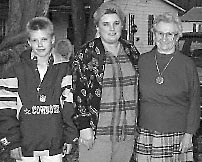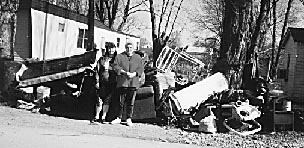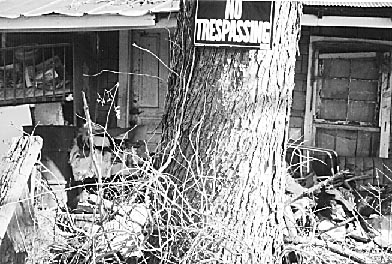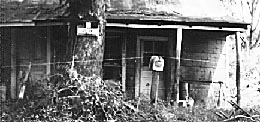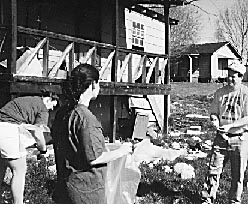| ||||||||||
Dr. Ronald P. Rogers CHIROPRACTOR Support for your body's natural healing capabilities 270-384-5554 Click here for details 


Columbia Gas Dept. GAS LEAK or GAS SMELL Contact Numbers 24 hrs/ 365 days 270-384-2006 or 9-1-1 Call before you dig Visit ColumbiaMagazine's Directory of Churches Addresses, times, phone numbers and more for churches in Adair County Find Great Stuff in ColumbiaMagazine's Classified Ads Antiques, Help Wanted, Autos, Real Estate, Legal Notices, More... 
|
Adair Social Action Committee Cleans Up Parrott Avenue This article first appeared in issue 11, and was written by Linda Waggener. A retired nun and a local resident are leaders in positive changes Not long after Heart of Adair got underway, a cleanup was organized on the square and volunteers got a dumpster full of garbage off the streets. Everyone was really proud until we heard about the quiet strength of the Adair County Social Action Committee which had just succeeded in getting eight dumpsters full of trash out of the Parrot Avenue community. At the time we asked its founder, Sister Dorothy McMannon, if she would tell how the committee had accomplished so very much. Almost a year and many more successes later, she has at last found the time to share her experiences. Sister Dorothy McMannon, OLVM, writes: During my 12 years of ministry at Good Shepherd Church, I received many requests for food, medical care, money for rent, etc. It seemed to me there had to be a better way to help people on a more permanent basis, not just in emergency situations. At my retirement 5 years ago I got a grant from the Campaign for Human Development-an organization funded by the Catholic Church through national collections each October. It is used exclusively for self-help programs. With this grant, The Adair County Social Action Committee came into being. A Board was formed. Versie Murphy, Rose Seelye, Dan Goldberg and I were charter members. We have since received funds from my religious community, and are now working with a grant from the Presbyterian Church in Louisville. We became a non-profit organization in January 1994. Our aim is to help people help themselves in order to reach a more fulfilling way of life. We began talking to people on both the professional and grass roots level to find an area of need. During this process we leaned that 42, or one out of every 10 girls in the high school, were either pregnant or already had a child. Over half of these students were not in school. We directed our efforts toward establishing the Teenage Pregnancy Program which began in the fall of 1995. The program is known as Project Happiness, an acronym that means Helping Adolescent Parents in Needed Education and Social Skills building. The program Directors are Loretta Rainwater and Phyllis Barbee. Kathy Janes is the Primary Child Care Provider. The aim of that program is to help young parents graduate from high school. To make this possible nursery care is provided. When students consent to take part in the program, they must agree to take Parenting, Nutrition, Human Growth and Development classes and also vocational classes that will prepare them for the work force. The students are also expected to spend one block in the first or second semester in the nursery helping with all the children and attending any special educational sessions provided by Mrs. Janes and other competent persons. Mrs. Barbee and Mrs. Rainwater are available for counseling at any time. While working on this program I had occasions to visit Parrott Avenue. I noticed several things. 1. There were no street lights since the area is outside of the city limits. By 5 PM it was pitch black. I realized children were getting on and of the bus in total darkness. 2. There were a number of vacant homes and lots that were piled with trash, overgrown with weeds These were definitely fire hazards and breeding grounds for rats. Trash was being dumped over the hill into the ravine and draining into Russell Creek. We later learned that most of the illegal dumping, especially that over the hillside, was being done by persons outside the area. One resident saw a truck back in and dump 5 used commodes. 3. When it rains some of the homes are literally standing in water. At our next board meeting we formed a committee made up of residents and other interested individuals: Marie Coyle, Dedie Hanson, Ruby Stotts, and Marsh Walker plus the current board members: Jim Chaffin, Bob Hanson, Dorothy McMannon, Versie Murphy and Rose Seelye. Each family, each land owner was visited individually I then visited each Parrot Avenue family "one by one" and talked "one on one." I asked what they would like to see happen in the neighborhood and what they would be willing to do to help. I assured them they could count on our help. This created a climate of trust. With rare exceptions the residents were delighted and promised their support. There are 32 families and 34 children, most of whom are under the age of 12. When the survey was completed, we found that the top priority was clean up. They wanted to get rid of rats, and create a better place for children. What effect was the present environment having on the self image of children? What negative message was being conveyed? The next priorities were street lights and traffic, both prompted by concern for the safety of the children. They have no place to play. Traffic is often heavy, due to several businesses. Dampness caused by standing water was also a health concern especially for the elderly and for parents of young children. Some have asthma, emphysema or other breathing problems. Over flowing septic tanks are clearly a health hazard for everyone. Another concern is difficulty in making a left turn onto 55 at busy hours of the day. One parent reported that recently his 2 year old daughter was having a seizure. He was afraid she would die before he could get her to the hospital. We also contacted absentee land owners, informed them of what we were doing, and asked them to clean up their property or let others do it for them. We held two neighborhood meetings so residents could share and ask any questions they wished. The meetings were held at the Jesus Name Mission Church on Parrott Ave. We appreciate the hospitality given us by the pastor Wayne Sneed. We have worked on the project since September, 1995. Though we still have much to do, we are pleased with what has happened so far. Judge Executive Jerry Vaughan had "Children at Play" signs put up immediately after we requested them Some residents installed their own security lights. Three home owners have consented to pay the monthly fee for street lights close to their property. We had a Clean Up Day last March. Lindsay Wilson students, under the direction of Jodi Carver, Dedie Hanson and Doctor Bill Luckey, offered their help. We visited all the families again to inform them of what was happening. We also sent around flyers just before the pick up. Judge Vaughan let us have the use of the county trucks and drivers. The response was overwhelming. On the Clean Up Day the residents and students helped clean empty lots, picked up trash along the roadside and loaded the trucks. Since the students could work only a couple of hours, the residents completed the loading of the trucks later in the week when the trucks and drivers were again available. We had a second Clean Up Day in October. Thanks to Judge Vaughan we again had the use of the county trucks and drivers, Kenny Downey and Lonnie Page, who, as always, were very helpful and cooperative. Lindsay Wilson students also helped. We deeply appreciate the time and effort they put into this project. This time we especially targeted those properties whose owners had not responded the first time. For example, at one site, Lindsey Wilson students worked a combined 6 hours cutting weeds on one property. Since their time was limited, later two residents, Mairie Coyle and Versie Murphy, spent a combined 15 hours on the same property. Others from the area who helped with the second clean up were: Lester Coyle, Lany Dial, Elizabeth Melton, and Joey Murphy. This clean up day, too, was very successful. The dumping charge for the two day clean up was $1840.00. Besides giving us the use of the trucks and the drivers, the county paid $115.50. We were able to get donations from private sources as well as from organizations totaling $350.00. Fortunately, we had enough money in our grant that we could use to cover the rest. Is the high cost of trash disposal one of the causes of illegal dumping? There is still much to be done, especially on the hillside leading to the creek. This site, when the leaves are down in the winter and early spring, can easily be seen by people leaving town and crossing the bridge. It can also be seen from Fairgrounds St. and from Young St. We are now very concerned about the drainage problem. Rudy Higgenbotham, from the Soil Conservation Office, will be surveying the area to see if and where tile can be laid. Once this is completed, we can get estimates and then take the information to the Fiscal Court. Have there been frustrations? Yes. When first beginning the project, I was told by an environmental- ist from outside the county that if I had any sense I would go home and forget about the project. That too many politicians were concerned about their jobs and would do nothing to rock the boat. Another told me she would not play "the bad cop." In other words, she would not enforce the law. Another, also from out of town, said he didn't see what we were concerned about. There are places in Eastern Kentucky worse than these. They've been that way for 100 years and they'll still be like that for another 100 years! When we were discussing the problem of mosquitoes due to the standing water, he told us we could solve the problem by putting a few drops of oil on the water. He added, "It's illegal, of course, but you can do it'." Other than this lack of cooperation of some officials, I suppose the greatest frustration has been in the time it takes to get something ac- complished. It takes a lot of persistence and patience. However, our frustrations were offset by the help of so many in the community and especially by the cooperation of the residents. When I visited, I was made to feel very welcome. I found the people to be open and friendly. On the whole, they take pride in their homes and even though they are unable to control their outside environment, they were deeply concerned about the neighborhood. Some homes have been in the family for generations. Most important of all, I think we have dispelled the myth that the residents "want to live that way." We found most of them eager to change the situation. They simply did not have the resources or the know how. I think Versie Murphy summed it up well when she said, "Just because we don't have the advantages other people have, doesn't mean we have to live this way." Since we began our project, many residents and home owners have worked hard to improve their property. To mention only a few: one house was winterized and painted, yards have been cleared of brush and dead foliage, and the hillside at the end of the street has been bulldozed. The people know that what they do will make a difference. Special thanks and recognition goes to Versie Murphy. We could not have accomplished what we did without her. She lives in the neighborhood and is a member of both the Board and the Committee. Her neighbors trust her. She is always ready to answer their questions. She shows by her example that everyone is important and everyone's help is needed. Many others deserve our thanks. Marie Coyle was always willing to help when called on no matter what the task. Our thanks also go to our Board and to the Committee who worked so hard to bring the project this far; to Judge Executive Jerry Vaughan; Mayor Curtis Hardwick; Jane Keltner, City Clerk; Donna Feese, PVA Office; Rudy Higgenbotham, Soil conservation Officer; Dean Antle, Kentucky Utilities; John Darnell, Lonnie Page and Kenny Downey, the County Road Department; Lindsay Wilson students and advisors, Jodi Carver, Dedie Hanson, and Doctor William Luckey; Wayne Sneed, Pastor of the Jesus Name Mission Church; and many others who answered our questions, offered information, and gave us suggestions and encouragement. A very special thanks goes to the many residents of Parrott Avenue who helped get us where we are today. I am convinced that as we move forward in Adair County, if we want to be truly successful, we cannot leave behind the less advantaged. Anyone interested in joining the Adair County Social Action Committee, or if you have suggestions for projects, call 384-2258. This story was posted on 1997-01-15 12:01:01
Printable: this page is now automatically formatted for printing.
Have comments or corrections for this story? Use our contact form and let us know.
More articles from topic News:
Hunter Durham Volunteers The Incorporation Of Heart Of Adair Landscape Architect Henson's Drawings Show Results Of Tree Grant Dollars At Wor Downtown At Its Dazzling Best For Christmas Event Hoa Asks, "what's Our Focus?" From The Journal Of Ed Waggener, 1977 2000 Celebration Of The Arts Festival Coming In September Progress Comes To Downtown Columbia In Living Color; Square Has First Purple Bu Buildings Blooming Art Of Adair Displayed At Festival Trends & Updates View even more articles in topic News |



|
||||||||
|
| ||||||||||
|
Quick Links to Popular Features
Looking for a story or picture? Try our Photo Archive or our Stories Archive for all the information that's appeared on ColumbiaMagazine.com. | ||||||||||
|
Contact us: Columbia Magazine and columbiamagazine.com are published by Linda Waggener and Pen Waggener, PO Box 906, Columbia, KY 42728. Please use our contact page, or send questions about technical issues with this site to webmaster@columbiamagazine.com. All logos and trademarks used on this site are property of their respective owners. All comments remain the property and responsibility of their posters, all articles and photos remain the property of their creators, and all the rest is copyright 1995-Present by Columbia Magazine. Privacy policy: use of this site requires no sharing of information. Voluntarily shared information may be published and made available to the public on this site and/or stored electronically. Anonymous submissions will be subject to additional verification. Cookies are not required to use our site. However, if you have cookies enabled in your web browser, some of our advertisers may use cookies for interest-based advertising across multiple domains. For more information about third-party advertising, visit the NAI web privacy site.
| ||||||||||

























